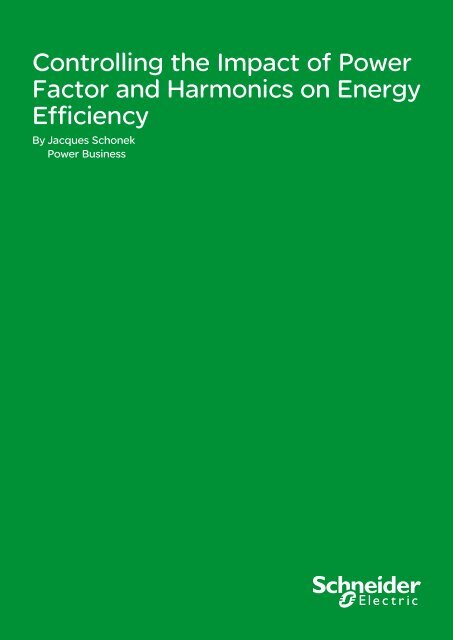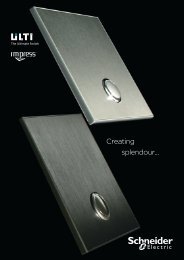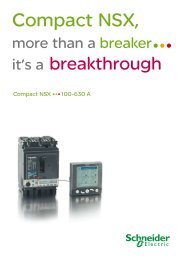Controlling the Impact of Power Factor and ... - Schneider Electric
Controlling the Impact of Power Factor and ... - Schneider Electric
Controlling the Impact of Power Factor and ... - Schneider Electric
You also want an ePaper? Increase the reach of your titles
YUMPU automatically turns print PDFs into web optimized ePapers that Google loves.
<strong>Controlling</strong> <strong>the</strong> <strong>Impact</strong> <strong>of</strong> <strong>Power</strong><br />
<strong>Factor</strong> <strong>and</strong> Harmonics on Energy<br />
Efficiency<br />
By Jacques Schonek<br />
<strong>Power</strong> Business
Summary<br />
Executive Summary.....................................................................................p 1<br />
Introduction..................................................................................................p 2<br />
Identifying <strong>and</strong> analyzing problem areas.......................................................p 4<br />
Harmonic mitigation <strong>and</strong> PFC solutions........................................................p 5<br />
Designing for energy efficiency.....................................................................p 7<br />
Harmonic mitigation <strong>of</strong> Variable Speed Drives (VSD).....................................p 8<br />
Conclusion...................................................................................................p 9
<strong>Controlling</strong> <strong>the</strong> <strong>Impact</strong> <strong>of</strong> <strong>Power</strong> <strong>Factor</strong> <strong>and</strong> Harmonics on Energy Efficiency<br />
Executive summary<br />
A <strong>Power</strong> <strong>Factor</strong> Correction (PFC) <strong>and</strong> harmonics mitigation plan will always<br />
improve <strong>the</strong> energy efficiency <strong>of</strong> electrical installations. Much like bumps <strong>and</strong><br />
holes in a road impede <strong>the</strong> progress <strong>of</strong> an automobile, distorted voltage in AC<br />
distribution systems negatively impacts operations <strong>and</strong> drives up expenses.<br />
This paper analyzes PFC <strong>and</strong> harmonics problem areas <strong>and</strong> <strong>of</strong>fers practical<br />
approaches for improvements.<br />
COM-POWER-WP02EN Rev1 |
<strong>Controlling</strong> <strong>the</strong> <strong>Impact</strong> <strong>of</strong> <strong>Power</strong> <strong>Factor</strong> <strong>and</strong> Harmonics on Energy Efficiency<br />
Introduction<br />
Design engineers <strong>and</strong> facility managers are now required to pay more<br />
attention to saving energy <strong>and</strong> improving <strong>the</strong> availability <strong>of</strong> clean electricity at<br />
<strong>the</strong>ir work sites. This paper is written to assist electrical installation designers<br />
in identifying out-<strong>of</strong>-phase <strong>and</strong> voltage distortion problem areas. In addition,<br />
various harmonics mitigation <strong>and</strong> PFC solutions are discussed. The goal is<br />
to leverage existing <strong>and</strong> new technologies to decrease OPEX <strong>and</strong> to improve<br />
energy efficiency within <strong>the</strong> site’s power infrastructure.<br />
COM-POWER-WP02EN Rev1 |
<strong>Controlling</strong> <strong>the</strong> <strong>Impact</strong> <strong>of</strong> <strong>Power</strong> <strong>Factor</strong><br />
<strong>and</strong> Harmonics on Energy Efficiency
<strong>Controlling</strong> <strong>the</strong> <strong>Impact</strong> <strong>of</strong> <strong>Power</strong> <strong>Factor</strong> <strong>and</strong> Harmonics on Energy Efficiency<br />
Identifying <strong>and</strong> analyzing problem areas<br />
In AC distribution systems, <strong>the</strong> maximum active<br />
power is transmitted to a load when voltage <strong>and</strong><br />
current are in phase <strong>and</strong> undistorted.<br />
When voltage <strong>and</strong> current are phase-shifted, <strong>the</strong><br />
instantaneous power P = V x I is negative when<br />
<strong>the</strong> signal signs are opposite. The average power<br />
is <strong>the</strong>n reduced compared to <strong>the</strong> situation where<br />
<strong>the</strong> signals are in phase. The relevant parameter is<br />
<strong>the</strong> Displacement <strong>Power</strong> <strong>Factor</strong> (DPF) which is <strong>the</strong><br />
cosine <strong>of</strong> <strong>the</strong> phase angle j between voltage <strong>and</strong><br />
current (cos j).<br />
When a current is distorted, <strong>the</strong> instantaneous<br />
power fluctuates significantly. The average power<br />
is <strong>the</strong>n reduced compared to a situation where<br />
<strong>the</strong> current is undistorted. The current distortion<br />
means that harmonics are present, generated by<br />
non-linear loads. The Total Harmonic Distortion<br />
(THD) is <strong>the</strong> usual parameter to evaluate <strong>the</strong><br />
distortion <strong>of</strong> current (THD i) or voltage (THD u).<br />
Therefore, low DPF <strong>and</strong> harmonics mean that <strong>the</strong><br />
power transfer to <strong>the</strong> load is not maximized for a<br />
given value <strong>of</strong> r.m.s. (root-mean-square) current. In<br />
o<strong>the</strong>r words, <strong>the</strong> current circulating in <strong>the</strong> electrical<br />
circuits is higher than what is strictly necessary for<br />
transmitting <strong>the</strong> active power to <strong>the</strong> machines.<br />
The <strong>Power</strong> <strong>Factor</strong> (PF) has been introduced to<br />
assess this phenomenon.<br />
For illustration, Figure 1 presents voltage <strong>and</strong><br />
current wave forms for different situations, but<br />
with <strong>the</strong> same active power P transmitted to <strong>the</strong><br />
load. With DPF = 0.7 or THDi = 100 %, <strong>the</strong> r.m.s.<br />
current is increased by more than 40 % for <strong>the</strong><br />
same active power.<br />
As <strong>the</strong> power losses in <strong>the</strong> circuits are proportional<br />
to <strong>the</strong> square <strong>of</strong> <strong>the</strong> r.m.s. current, <strong>the</strong> power<br />
losses in <strong>the</strong> two non-ideal situations are doubled.<br />
These additional power losses mean more CO 2<br />
emission, premature ageing, higher electricity cost,<br />
<strong>and</strong> higher equipment cost.<br />
Ano<strong>the</strong>r major consequence <strong>of</strong> harmonics is<br />
<strong>the</strong> deterioration <strong>of</strong> <strong>the</strong> supply voltage quality.<br />
The circulation <strong>of</strong> harmonic currents through <strong>the</strong><br />
system impedance creates voltage harmonics<br />
resulting in voltage distortion. The negative impact<br />
may remain un-noticed, with adverse economic<br />
results.<br />
<strong>Power</strong> <strong>Factor</strong> Correction <strong>and</strong> proper harmonic<br />
mitigation can contribute to improved operations<br />
within companies in several ways:<br />
• reduced overloading on <strong>the</strong> electrical system<br />
<strong>the</strong>reby releasing useable capacity<br />
reduced system losses <strong>and</strong> dem<strong>and</strong> power<br />
reduced risks <strong>of</strong> outage<br />
extended equipment lifetime.<br />
•<br />
•<br />
•<br />
I<br />
V<br />
DPF = 1<br />
THDi= 0<br />
PF = 1<br />
I rms = I<br />
Figure 1<br />
Sample situations impacting<br />
power factor.<br />
I<br />
V<br />
DPF ≈1<br />
THDi= 100%<br />
PF = 0.71<br />
I rms = 1.41 x I<br />
V<br />
I<br />
DPF = 0.7<br />
THDi= 0<br />
PF = 0.7<br />
I rms = 1.43 x I<br />
COM-POWER-WP02EN Rev1 |
<strong>Controlling</strong> <strong>the</strong> <strong>Impact</strong> <strong>of</strong> <strong>Power</strong> <strong>Factor</strong> <strong>and</strong> Harmonics on Energy Efficiency<br />
Harmonic mitigation <strong>and</strong> PFC solutions<br />
Numerous approaches can be deployed to<br />
address harmonics <strong>and</strong> power factor issues in a<br />
facility. The following section illustrates some <strong>of</strong> <strong>the</strong><br />
main categories <strong>of</strong> options.<br />
Capacitor banks<br />
Capacitor banks (see Figure 2) improve <strong>Power</strong><br />
<strong>Factor</strong> Correction <strong>and</strong> help to avoid reactive<br />
energy penalties charged by <strong>the</strong> utility. Capacitor<br />
bank equipment may be connected at <strong>the</strong><br />
following levels <strong>of</strong> <strong>the</strong> facility’s power infrastructure<br />
installation: medium voltage (MV) substation, low<br />
voltage (LV) main switchboard, LV secondary<br />
switchboard, <strong>and</strong> machine terminals.<br />
G h /S n<br />
50%<br />
rated<br />
overrated<br />
detuned<br />
Filters<br />
Classic<br />
Comfort<br />
Harmony<br />
Figure 3 – Selection criteria.<br />
Figure 2 – Example <strong>of</strong> low voltage capacitor banks.<br />
When capacitor banks are installed in <strong>the</strong> presence<br />
<strong>of</strong> harmonics, two parameters shall be considered:<br />
G h<br />
: total power <strong>of</strong> <strong>the</strong> non-linear loads,<br />
S n<br />
: rated power <strong>of</strong> <strong>the</strong> supply transformer.<br />
Different types <strong>of</strong> equipment must be selected<br />
depending on <strong>the</strong> level <strong>of</strong> <strong>the</strong> network harmonic<br />
emission. The selection is based on <strong>the</strong> value <strong>of</strong><br />
<strong>the</strong> G h<br />
/S n<br />
ratio, as illustrated in Figure 3:<br />
The following points should be considered when<br />
selecting capacitors:<br />
Overrated capacitors must be selected when<br />
G h<br />
/S n<br />
exceeds 15 % because harmonic currents<br />
will be responsible for increased stress.<br />
When G h<br />
/S n<br />
exceeds 25 %, a series reactor<br />
is necessary to protect <strong>the</strong> capacitors against<br />
harmonic currents. This is called a detuned reactor<br />
because capacitors <strong>and</strong> <strong>the</strong> reactor are set up in<br />
a resonant circuit configuration, not tuned to <strong>the</strong><br />
frequency <strong>of</strong> any harmonic order.<br />
Passive filters are implemented when <strong>Power</strong><br />
<strong>Factor</strong> Correction is requested with a high level <strong>of</strong><br />
existing harmonic distortion. These filters consist <strong>of</strong><br />
reactors <strong>and</strong> capacitors set up in a resonant circuit<br />
configuration, <strong>and</strong> are tuned to <strong>the</strong> frequency <strong>of</strong><br />
<strong>the</strong> harmonic order to be eliminated. A system may<br />
be composed <strong>of</strong> a number <strong>of</strong> filters to eliminate<br />
several harmonic orders.<br />
Active filters<br />
Active filters are systems employing power<br />
electronics which provide <strong>the</strong> harmonic currents<br />
required by nonlinear loads <strong>the</strong>reby avoiding<br />
distortion on <strong>the</strong> power system.<br />
The active filter injects, in opposite phase, <strong>the</strong><br />
harmonics drawn by <strong>the</strong> load, such that <strong>the</strong> line<br />
current remains sinusoidal.<br />
COM-POWER-WP02EN Rev1 |
<strong>Controlling</strong> <strong>the</strong> <strong>Impact</strong> <strong>of</strong> <strong>Power</strong> <strong>Factor</strong> <strong>and</strong> Harmonics on Energy Efficiency<br />
Hybrid filters<br />
Hybrid filters are systems that include a passive<br />
filter <strong>and</strong> an active filter in a single unit. They<br />
combine <strong>the</strong> advantages <strong>of</strong> both technologies <strong>and</strong><br />
provide an optimum cost / performance ratio.<br />
Electronic compensators<br />
Figure 4 - Examples <strong>of</strong> active <strong>and</strong> hybrid filters.<br />
Active or hybrid filters are also capable <strong>of</strong><br />
compensating for low values or fluctuations <strong>of</strong> <strong>the</strong><br />
Displacement <strong>Power</strong> <strong>Factor</strong>.<br />
In this mode <strong>of</strong> operation, <strong>the</strong>y are also known as<br />
"Static Var Compensators" (SVC) or "Hybrid Var<br />
Compensators" (HVC).<br />
Solutions that support Variable Speed Drives (VFD)<br />
AC-Line or DC-link chokes are commonly used<br />
with drives up to about 500kW unit power. When<br />
a large number <strong>of</strong> drives are present within an<br />
installation, <strong>the</strong> use <strong>of</strong> AC-Line or DC-link chokes<br />
for each individual drive is recommended. This<br />
measure increases <strong>the</strong> lifetime <strong>of</strong> <strong>the</strong> drives <strong>and</strong><br />
enables use <strong>of</strong> cost effective mitigation solutions,<br />
such as active filters, for example, at <strong>the</strong> time <strong>of</strong><br />
installation (see Figure 5).<br />
C-less technology applies to Variable Speed Drives<br />
<strong>and</strong> <strong>of</strong>fers a reduced current distortion compared<br />
to traditional technology. Combined with an<br />
advanced control algorithm, this solution is suitable<br />
for applications with low over-torque requirements<br />
like centrifugal pumps, fans <strong>and</strong> HVAC machines.<br />
Mains<br />
AC-line<br />
choke<br />
DC-line<br />
choke<br />
winding transformer providing a 12-pulse supply<br />
for <strong>the</strong> drive is considered st<strong>and</strong>ard. This limits <strong>the</strong><br />
harmonic emission <strong>and</strong>, in most cases, no fur<strong>the</strong>r<br />
mitigation is necessary. Multi-pulse solutions are<br />
<strong>the</strong> most efficient in terms <strong>of</strong> power losses <strong>and</strong><br />
compliance to st<strong>and</strong>ards is simplified.<br />
Mains<br />
3-winding<br />
transformer<br />
Figure 6 - Multi-pulse arrangement.<br />
An Active Front End (AFE) is <strong>the</strong> best performing<br />
solution concerning harmonic mitigation with<br />
drives, limiting <strong>the</strong> THDi below 5 % (see Figure 7).<br />
All <strong>the</strong> applicable st<strong>and</strong>ard requirements can be<br />
met. No detailed system evaluation is necessary,<br />
making this solution <strong>the</strong> easiest to implement. In<br />
addition to harmonic mitigation, power regeneration<br />
<strong>and</strong> power factor correction are inherent.<br />
Figure 5 – Chokes for drives.<br />
Line-filter<br />
A multi-pulse arrangement is <strong>of</strong>ten used for drives<br />
above 400 kW, but could also be a reasonable<br />
solution for smaller power ratings (see Figure 6).<br />
A precondition is a dedicated transformer directly<br />
supplied from <strong>the</strong> MV network. The use <strong>of</strong> a 3-<br />
Mains<br />
Figure 7 - Active Front End configuration.<br />
COM-POWER-WP02EN Rev1 |
<strong>Controlling</strong> <strong>the</strong> <strong>Impact</strong> <strong>of</strong> <strong>Power</strong> <strong>Factor</strong> <strong>and</strong> Harmonics on Energy Efficiency<br />
Designing for energy efficiency<br />
In <strong>the</strong> domain <strong>of</strong> electrical installations, energy<br />
efficiency is defined as follows:<br />
• energy savings: reduction in energy<br />
consumption<br />
• energy cost optimization: reduction in <strong>the</strong> cost <strong>of</strong><br />
energy paid to <strong>the</strong> utility<br />
• availability <strong>and</strong> reliability: reduction in <strong>the</strong> risk <strong>of</strong><br />
outage, <strong>and</strong> efficient equipment operation.<br />
PFC <strong>and</strong> harmonic mitigation impacts all 3 aspects<br />
<strong>of</strong> energy efficiency in <strong>the</strong> following ways:<br />
• Reduction <strong>of</strong> <strong>the</strong> power losses in transformers,<br />
cables, switchgear, motors, capacitors<br />
• Reduction <strong>of</strong> <strong>the</strong> dem<strong>and</strong> power (in MVA),<br />
resulting in lower electrical bills<br />
• Optimization <strong>of</strong> total system capacity, without<br />
risk <strong>of</strong> overload, nuisance tripping or premature<br />
ageing <strong>of</strong> equipment.<br />
Parameters to be considered<br />
In order to better manage harmonics, <strong>the</strong> following<br />
parameters should be considered:<br />
Network parameters<br />
It is important to underst<strong>and</strong> <strong>the</strong> characteristics<br />
<strong>of</strong> <strong>the</strong> power network in order to be able to<br />
accommodate conditions at <strong>the</strong> Point <strong>of</strong> Common<br />
Coupling (PCC)–this is <strong>the</strong> point where <strong>the</strong><br />
installation is connected to <strong>the</strong> utility network, <strong>and</strong><br />
where o<strong>the</strong>r utility customers may be connected.<br />
The system size (known by power or impedance)<br />
<strong>and</strong> topology both have an influence on <strong>the</strong><br />
resulting harmonic distortion.<br />
Industry<br />
Applicable st<strong>and</strong>ards vary depending upon <strong>the</strong><br />
environmental characteristics <strong>of</strong> industry specific<br />
facilities. Relevant st<strong>and</strong>ards in residential,<br />
commercial or light industry sectors are generally<br />
applicable to pieces <strong>of</strong> equipment. St<strong>and</strong>ards in<br />
heavy industry sectors, on <strong>the</strong> o<strong>the</strong>r h<strong>and</strong>, are<br />
applicable to global installations <strong>and</strong> not at <strong>the</strong><br />
individual component level. Thus, central mitigation<br />
is generally more cost effective in heavy industry<br />
sectors.<br />
Applicable harmonic st<strong>and</strong>ard<br />
Once industry <strong>and</strong> network parameters are<br />
determined, <strong>the</strong> applicable st<strong>and</strong>ards should be<br />
enforced. Exceeding <strong>the</strong> st<strong>and</strong>ard requirements,<br />
however, will result in a higher investment than<br />
is needed. On <strong>the</strong> o<strong>the</strong>r h<strong>and</strong>, application <strong>of</strong><br />
excessively relaxed st<strong>and</strong>ards can result in<br />
higher energy <strong>and</strong> maintenance costs, as well as<br />
disturbances on <strong>the</strong> mains.<br />
Project drivers<br />
Whenever an investment is necessary, it is<br />
important to set a priority concerning <strong>the</strong> project<br />
drivers. A solution optimized for a low Capex may<br />
result in higher Opex <strong>and</strong> vice versa. Performance<br />
specifications for a solution will also impact both<br />
Capex <strong>and</strong> Opex.<br />
Applicable reactive energy penalties<br />
The contractual arrangements with energy<br />
suppliers can also influence <strong>the</strong> design <strong>of</strong> <strong>the</strong><br />
installation. If penalties for exceeding reactive<br />
energy limits are in place, <strong>the</strong> implementation<br />
<strong>of</strong> <strong>Power</strong> <strong>Factor</strong> Correction capacitors should<br />
be considered. However, if harmonic current<br />
generators <strong>and</strong> capacitor banks are present,<br />
current <strong>and</strong> voltage distortions may be amplified<br />
(resonance phenomenon). This has a significant<br />
impact on <strong>the</strong> resulting harmonic distortion. Thus,<br />
a simultaneous review <strong>of</strong> both PFC <strong>and</strong> harmonic<br />
mitigation should be considered <strong>and</strong> additional<br />
precautionary measures may need to be taken.<br />
Ratio <strong>of</strong> non-linear load power to total load<br />
power<br />
The higher <strong>the</strong> share <strong>of</strong> non-linear loads compared<br />
to <strong>the</strong> total load power <strong>of</strong> an installation, <strong>the</strong> higher<br />
<strong>the</strong> necessity for evaluation <strong>of</strong> harmonics.<br />
COM-POWER-WP02EN Rev1 |
<strong>Controlling</strong> <strong>the</strong> <strong>Impact</strong> <strong>of</strong> <strong>Power</strong> <strong>Factor</strong> <strong>and</strong> Harmonics on Energy Efficiency<br />
Harmonic mitigation <strong>of</strong> Variable Speed<br />
Drives (VSD)<br />
The installation <strong>of</strong> Variable Speed Drives (see<br />
Figure 8) should take into account <strong>the</strong> following<br />
considerations:<br />
•<br />
if <strong>the</strong> motor driven by <strong>the</strong> VSD is newly installed,<br />
<strong>the</strong> availability <strong>of</strong> power from <strong>the</strong> supply system<br />
should be checked<br />
• <strong>the</strong> <strong>Power</strong> <strong>Factor</strong> Correction has to be revised,<br />
as no significant reactive energy is requested<br />
anymore by <strong>the</strong> VSD driven motor<br />
• <strong>the</strong> impact <strong>of</strong> harmonics has to be analysed,<br />
both in terms <strong>of</strong> possible disturbances <strong>and</strong><br />
compliance to st<strong>and</strong>ards.<br />
Steps for deploying a solution<br />
Figure 9<br />
Variable Speed Drives in a<br />
pumping station<br />
The evaluation <strong>and</strong> selection <strong>of</strong> a suitable<br />
harmonics mitigation solution should include <strong>the</strong><br />
following three steps:<br />
1. Select <strong>the</strong> relevant harmonic emission limit<br />
(equipment or installation st<strong>and</strong>ard)<br />
This step identifies <strong>the</strong> applicable st<strong>and</strong>ards. The<br />
st<strong>and</strong>ards can apply to specific equipment or to<br />
a global installation. As <strong>the</strong> limits applicable at<br />
<strong>the</strong> installation level are generally more restrictive,<br />
applying <strong>the</strong>se limits at <strong>the</strong> equipment level is not<br />
cost effective.<br />
2. If harmonic mitigation is needed or<br />
advisable, consider equipment mitigation first<br />
For drives totalling a power load <strong>of</strong> up to 100 kW:<br />
• this power usually represents less than ~20 % <strong>of</strong><br />
<strong>the</strong> transformer rated power. The st<strong>and</strong>ard solution<br />
is to use AC-Line or DC-link chokes.<br />
For total drives power from about 100 kW up to<br />
about 1,000 kW:<br />
• in this power range, it is advisable to have <strong>the</strong><br />
transformer power equal to at least 2.5 times <strong>the</strong><br />
drives load. The st<strong>and</strong>ard solution is to use AC-<br />
Line or DC-link chokes.<br />
For drives whose power load ranges from 100 kW<br />
to 1,000 kW:<br />
• in this power range, drives are usually equipped<br />
with a dedicated transformer directly supplied<br />
from <strong>the</strong> MV network. A 3-winding transformer is<br />
commonly used, providing a 12-pulse supply for<br />
<strong>the</strong> drives. This limits <strong>the</strong> harmonic emission <strong>and</strong>,<br />
in most cases, no fur<strong>the</strong>r mitigation is necessary. In<br />
addition, multi pulse solutions are <strong>the</strong> most efficient<br />
in terms <strong>of</strong> power losses. This allows for easy<br />
compliance to <strong>the</strong> most stringent st<strong>and</strong>ards.<br />
3. Check impact on existing equipment <strong>of</strong><br />
installation<br />
When a new non-linear load is connected to<br />
an existing installation, it has to be determined<br />
if it influences <strong>the</strong> o<strong>the</strong>r components already<br />
connected on <strong>the</strong> same network. This is relevant<br />
for capacitors <strong>and</strong> active filters in particular. Below<br />
are some examples <strong>of</strong> common scenarios:<br />
• if capacitors are already present in <strong>the</strong><br />
installation (<strong>Power</strong> <strong>Factor</strong> Correction or passive<br />
harmonic filter), <strong>the</strong>re is a risk <strong>of</strong> overload <strong>and</strong><br />
resonance introduced by <strong>the</strong> additional harmonic<br />
currents. Usually <strong>the</strong> supplier <strong>of</strong> <strong>the</strong> PFC or passive<br />
filter is able to evaluate <strong>the</strong> situation <strong>and</strong> should be<br />
contacted first.<br />
• if passive or hybrid filters are present, <strong>the</strong><br />
installed filter can be kept unchanged if it is<br />
oversized <strong>and</strong> can match <strong>the</strong> new current<br />
requirements. O<strong>the</strong>rwise, <strong>the</strong> passive element<br />
must be redesigned, as it is not possible to<br />
connect ano<strong>the</strong>r element in parallel with exactly <strong>the</strong><br />
same frequency tuning.<br />
• if an active filter is present, non-linear loads<br />
must always be equipped with line chokes. This<br />
will significantly reduce <strong>the</strong> harmonic current<br />
emission <strong>and</strong> thus <strong>the</strong> necessary current rating<br />
<strong>of</strong> <strong>the</strong> active filter. No risk is introduced by <strong>the</strong><br />
additional harmonic currents as <strong>the</strong> active filters<br />
are usually protected against overload. However,<br />
<strong>the</strong> cancellation <strong>of</strong> harmonic currents may not be<br />
totally effective, <strong>and</strong> <strong>the</strong> global performance may<br />
be deteriorated. Usually <strong>the</strong> network designer<br />
is able to evaluate <strong>the</strong> situation <strong>and</strong> should be<br />
contacted first.<br />
COM-POWER-WP02EN Rev1 |
<strong>Controlling</strong> <strong>the</strong> <strong>Impact</strong> <strong>of</strong> <strong>Power</strong> <strong>Factor</strong> <strong>and</strong> Harmonics on Energy Efficiency<br />
Conclusion<br />
<strong>Power</strong> <strong>Factor</strong> <strong>and</strong> harmonics, because <strong>of</strong> <strong>the</strong>ir<br />
impact on energy efficiency, are important issues<br />
to consider for <strong>the</strong> management <strong>of</strong> electrical<br />
installations. Multiple approaches are analyzed<br />
<strong>and</strong> explained so that performance <strong>of</strong> electrical<br />
systems can be optimized.<br />
Solutions for <strong>Power</strong> <strong>Factor</strong> Correction <strong>and</strong><br />
harmonic mitigation have been presented in a<br />
practical way, answering basic questions frequently<br />
asked by electrical installation designers.<br />
<strong>Power</strong> <strong>Factor</strong> Correction <strong>and</strong> harmonics mitigation<br />
both provide immediate benefits in terms <strong>of</strong><br />
reduced power losses <strong>and</strong> reduced electricity<br />
bills. In addition, both <strong>of</strong> <strong>the</strong>se best practices<br />
encourage <strong>the</strong> use <strong>of</strong> total system capacity in<br />
electrical installations <strong>the</strong>reby increasing payback<br />
on investment.<br />
COM-POWER-WP02EN Rev1 |
<strong>Schneider</strong> <strong>Electric</strong> Industries SAS<br />
35, rue Joseph Monier<br />
CS 30323<br />
F- 92506 Rueil Malmaison Cedex<br />
RCS Nanterre 954 503 439<br />
Capital social 896 313 776 €<br />
www.schneider-electric.com<br />
COM-POWER-WP02EN<br />
This document has been<br />
printed on ecological paper<br />
09-2009<br />
© 2009 - <strong>Schneider</strong> <strong>Electric</strong> - All rights reserved.

















